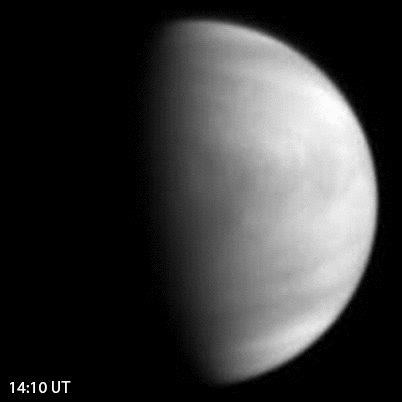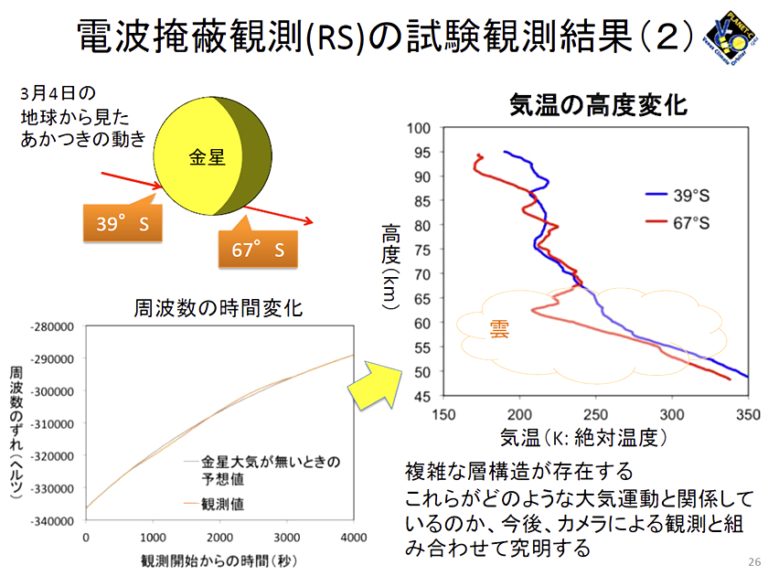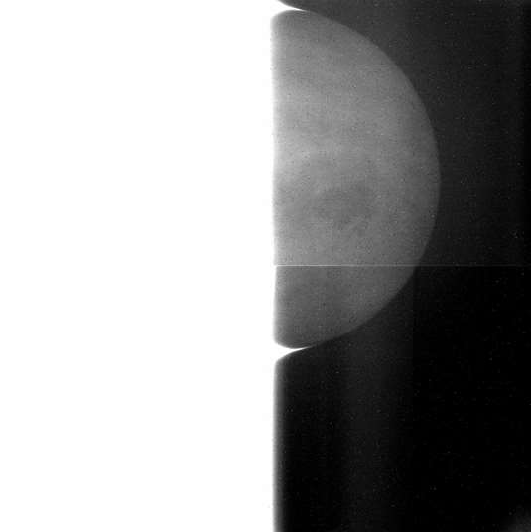Emily Lakdawalla • May 19, 2016
Akatsuki begins a productive science mission at Venus
This post is a little delayed, but I hope it will still be welcome because the news is good: Japan's Akatsuki Venus orbiter is well into its science mission, and has already produced surprising science results. Project manager Masato Nakamura presented first results at the International Venus Conference in early April; his presentation was summarized in detail by Elizabeth Gibney for Nature News. The mission also posted a very detailed presentation about mission status and early science results dated March 31 (PDF). Since then, an unmannedspaceflight.com user who goes by "pandaneko" has been doggedly translating the text on all of the slides.
This post summarizes his translations, with a little additional help from Gibney's article. Numbers in brackets refer to specific presentation slides as translated by pandaneko. Any errors are mine, and I welcome corrections in the comments.
Akatsuki entered orbit on December 7, 2015. Following an orbit correction on December 20, Akatsuki was placed successfully into the orbit planned for its redesigned science mission. As of March 31, 2016, it had already achieved the minimum success criteria of that new mission, and they are now working toward achieving the goals of the research plan outlined for Akatsuki before its launch. The current orbit is highly elongated, so most of Akatsuki's images are lower-resolution than intended, but this is partially compensated by the fact that Akatsuki is able to observe continuously for a long period. [4]
What, exactly, are Akatsuki's science goals? It's intended to study Venus' atmospheric dynamics; of particular interest is the mechanism that drives the super-rotation of Venus' atmosphere. (Venus rotates extremely slowly, but its entire atmosphere moves around the planet once every four days.) Akatsuki carries 5 science instruments that see in different parts of the electromagnetic spectrum. Different wavelengths penetrate to different depths in Venus' thick, cloudy atmosphere, so by viewing Venus in different wavelengths, Akatsuki sees Venus' atmosphere at different elevations. [5]
Already, Akatsuki has achieved its minimum-success goals. These included capturing views of the movement of the cloud structure over a one-week period by any one of the cameras. To achieve full success:
- Akatsuki will need to perform imaging using the IR1, IR2, UVI, and LIR cameras every few hours over a 2-year period in order to study the 3D structure of atmospheric dynamics. In its current orbit, it should be able to do this, although its long distance from Venus will mean that the observations have resolution 5 times poorer than originally planned.
- Akatsuki will search for lightning on Venus using its LAC, but will perform these observations only 10% as frequently as originally planned.
- Akatsuki will study the temperature structure of Venus' atmosphere using radio occultations, but only 10% as frequently as originally planned.
Akatsuki has the potential to perform extra science beyond its primary goals, including looking for volcanic activity with the IR1 camera and observing zodiacal light with IR2. And the longer Akatsuki can survive beyond its initial 2-year mission, the more opportunity it will have to observe long-term changes in Venus' atmospheric behavior, as Venus Express did. [6] According to Gibney, Nakamura stated that "if another small manoeuvre in two years’ time is successful...the spacecraft might avoid Venus’s solar-power-draining shadow, and so be able to orbit the planet for five years, rather than the two it was initially assigned." An orbit correction on April 4 helped set up Akatsuki for long-term survival.
This diagram shows how Akatsuki will perform different types of observations over the course of each long orbit: [7]
Its orbit is 10.5 days long and reaches out to 360,000 kilometers away from Venus at apoapsis. Its periapsis will range from 1000 to 10000 kilometers. During its long commissioning phase, controllers got the high-gain antenna working and confirmed that flying into eclipse does not cause power or temperature problems with the spacecraft. They also tested Akatsuki under a variety of solar illumination conditions. [8]
After orbit insertion LIR, IR1, and UVI cameras were all working immediately. The IR2 camera was put to work on December 11. On February 1, the ultrastable oscillator, a crucial component for radio occultation experiments, was up and running. The LAC can only be used when Akatsuki is on the night side of Venus, once every 10 days. It is expected to move into normal operation some time in May. [9]
There was one operational hiccup on February 20, but "it returned to normal" and "the causes were examined and necessary measures were taken." [10]
Detailed information on instrument status:
- The IR1 camera is functioning properly. The image taken immediately after VOI was exposed for daylight, but IR1 also obtained nightside images showing the ground surface later.
- The IR2 camera successfully captured an image of daylit clouds immediately after VOI. The instrument was being cooled in order to improve its performance, so its success rate in capturing nightside images was steadily increasing.
- The LIR camera is functioning properly and observing "exceptionally interesting, hitherto unreported phenomena" (see below for more on that).
- The UVI camera was not used much right after VOI because Akatsuki's orbit took it to on the nightside of Venus. Beginning in April, it was able to see the dayside and began imaging.
- LAC: Observations had not yet started.
- Radio science: The frequency stability of the ultrastable oscillator has not deteriorated during the long cruise. The first radio occultation was performed on March 4. [11]
The presentation then goes into specifics of what can be observed in different images. I won't include all the images here. With dayside imaging, the IR1 camera can detect cloud movements, mapping the distribution of winds at altitudes around 60 kilometers. [14] With nightside imaging, IR1 clearly detected Venus' surface. The higher-elevation Aphrodite Terra shows up as a dark spot in this thermal image. [15] Although they're fairly low resolution, these images are exciting to me because we're glimpsing a surface otherwise utterly hidden from view.

Here are two more views; the left half of each image is white because the daylit side of Venus saturates the detector. [16]
Dayside observations with the IR2 camera give Venus a streaky appearance. The streaky pattern results from variations in the heights of cloud tops. Poleward of about 50 degrees north and south latitude, Venus appears darker, meaning that the clouds are lower in elevation. [17,18] Later in the presentation, the polar clouds are estimated to be lower in altitude by 4 kilometers. [28]
When the report was written, LIR had just begun normal operations. LIR observed acruate structures crossing Venus at an early evening longitude, crossing the full disk from northern to southern hemispheres. They were observed immediately after orbit insertion on December 7 and persisted for 4 days. Phenomena of this kind have not been observed previously. (Note: LIR images should be credited to the National Institute of Advanced Industrial Science and Technology.) [19] In her summary, Gibney noted that the pattern appeared to move at the rate of the rotation of the surface, not at the rate of Venus' atmospheric super-rotation.

However, when similar observations were repeated from January 31 to February 2 as Akatsuki passed through periapsis, the arcuate structure observed on December 7 was not seen again. [20] A mystery for Akatsuki to solve!
Akatsuki's UVI observes in two wavelengths, 283 and 365 nanometers. The 365-nanometer wavelength is similar to previous missions' ultraviolet imagers, overlapping in wavelength with Pioneer Venus and Venus Express VMC and slightly shorter-wavelength than Galileo's UV filter. But the 283-nanometer wavelength is in an absorption band of sulfur dioxide. Akatsuki will study the origins of the clouds and the strange ultraviolet-absorbing material in them. [21]
You can see the motion of the clouds as seen in ultraviolet wavelengths in these 3 images taken shortly after orbit insertion. [22]

Is there lightning on Venus? This has been a subject of debate for 30 years; everybody is waiting for decisive evidence from LAC. [23] Full-scale observations with LAC are expected to begin in June. Operation is only possible for 1 hour every 10 days. Recording is performed at a rate of 30,000 times per second to separate out lightning from noise. [24]
Tests of radio occultations have gone well; initial observations were made on March 4 and 25. [25] The March 4 occultation measured Venus' atmospheric temperature profile down to an altitude of just below 50 kilometers. Complex layer structure is visible in the temperature profiles; how it's related to atmospheric motion will be examined as more data comes in from other instruments.[26]

In the future, the Akatsuki mission hopes to perform a lot of interesting science by taking advantage of multiple data sets. For instance, it's interesting that the polar darkening observed in the daylight IR2 images -- interpreted to suggest that Venus' cloud deck is 4 kilometers lower in elevation at those latitudes -- has no equivalent structure in the daylight IR1 images. [27] As another example, in nighttime imaging, where the IR1 camera can see the ground, there is other structure visible that is also visible in the IR2 images. Therefore, IR2 images could be used to filter clouds out of IR1 images. [28] Akatsuki will try to sort out lots of questions about what makes the cloud patterns visible in UV images.
The next several pages -- 29-33 -- describe some of the different hypotheses about Venus' atmosphere that the Akatsuki team hope to sort out with future work; 36-41 provide detailed instrument descriptions. You can read pandaneko's translations of all of those pages beginning here.
Finally, here's the most recent image release from Akatsuki, a colorful view based upon two different-wavelength images from the IR2 camera.

Many, many thanks to pandaneko for his hard work in translating these and other JAXA presentations!
Support our core enterprises
Your support powers our mission to explore worlds, find life, and defend Earth. You make all the difference when you make a gift. Give today!
Donate

 Explore Worlds
Explore Worlds Find Life
Find Life Defend Earth
Defend Earth





